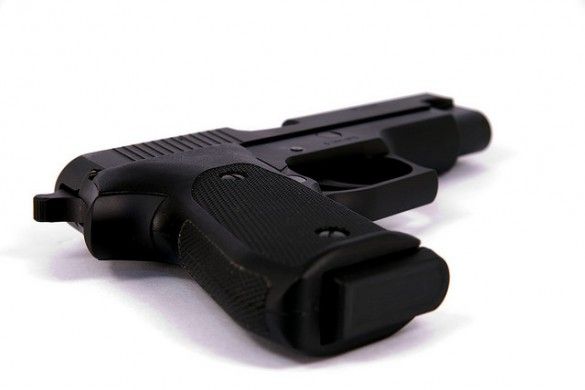Regulating Nation’s Firearms Ain’t No Shot In The Dark

BETWEEN THE LINES: After the January 2011 Arizona shooting spree when six were killed, including a 9-year-old girl, and more than a dozen injured, most notably U.S. Representative Gabrielle Giffords, gun violence in America again became the focus of debate for several weeks.
Despite the predictable healthy dose of rhetoric in the aftermath of such tragedies, no remedies have ever resulted, nor has a damn thing ever been done, to change gun laws.
The relentless argument about whether or not our society has too many guns — it’s estimated there’s at least one firearm for every American — seems to be reflected in several news stories that have hogged headlines nationwide so far this year.
Here’s a sample:
- A gunman opened fire at a small Christian university in Oakland, California, last week, killing at least seven people, wounding three more and setting off an intense, chaotic manhunt that ended with his capture at a nearby shopping center.
- A teenager, described in media reports as a bullied outcast, opened fire in a suburban Cleveland high school cafeteria in late February, killing three students and wounding two others before being caught.
- The most recurring news story for the last several weeks has been the furor over the Trayvon Martin shooting in which neighborhood watch captain George Zimmerman shot and killed the unarmed Stanford, Florida, teenager, claiming self-defense, under the state’s controversial “stand your ground” law. Zimmerman told police he shot Martin in self-defense when the youth, who he was following, attacked him. In a released 911 call, Zimmerman said that he had followed the suspicious looking teen “in a hoodie, walking slowly and looking into houses.”
- Just as I was preparing to file this column it was reported that four officers were wounded in Sheepshead Bay early Sunday morning after they engaged in a gun battle with one gunman. Afterwards, Police Commissioner Ray Kelly noted that the handgun used by the shooter was originally bought in Wilmington, North Carolina, and the sawed-off rifle had been stolen in Florida. Two states with lax rules for gun ownership.
Decades after the Virginia Tech and Columbine school shooting massacres, they remain grim echoes in our national conscience and resurface in most gun control squabbles.
Though some members of Congress say they advocate meaningful gun control, when push comes to shove, they seldom have the guts to challenge the potent National Rifle Association, even when it comes to banning AK-47s or other assault weapons that can kill dozens in a few seconds. Politicians avoid tackling the issue rather than face certain backlash from the well-funded gun lobby and its influence on gun-owning voters at the polls.
A couple of years ago, when writing on the subject for the umpteenth time, I learned that from 2004 to 2010, more than 600 individuals on the terrorist watch list underwent background checks when they attempted to purchase firearms or explosives. However, if an individual on the list does not have a felony conviction, illegal alien status or other prohibitive information, the firearms transaction is acceptable and not pursued by law enforcement. The Government Accounting Office, which tracks such purchases, reported in 2010 that more than 1,000 (91 percent) of such purchases went unchecked.
The incident in Sheepshead Bay early Sunday morning called attention to Mayor Bloomberg’s steadfast campaign to urge Congress to enact tougher gun laws.
Testifying at a hearing before Congress two years ago, Bloomberg, a staunch advocate to combat illegal guns, asked South Carolina Republican Senator Lindsey Graham if someone is on a no-fly list, isn’t it “reasonable to assume that person should not be allowed to buy a gun.”
Proposed legislation in the Senate went nowhere because Graham and his steadfast gun ownership advocates said such a law “would deny U.S. citizens on the terrorist watch list their Second Amendment rights.”
Graham added, with a straight face, “There’s no constitutional right to fly, but there is one to keep and bear arms.”
To Graham and his ilk, I say if you make gun laws stricter and make it mandatory to license all firearms — like we do our pets, cars and bicycles — there’s likely to be fewer guns to kill people.
Maybe, if federal and state lawmakers stop kowtowing to the NRA, sensible gun laws could be enacted.
Sometimes it seems the NRA and its gun-obsessed members value their misguided Second Amendment right to possess firearms more than America’s safety. Although the nation has experienced a drop in overall crime in the last decade, according to the National Institute of Justice, gun-related murders have slightly increased in that period.
I’m fed up with those who ignore early American history and the impetus for the Second Amendment. Colonists were ruled by a foreign power for decades and one method to contest the oppression was to put weapons in the hands of a “regulated militia.”
Today, besides a few wacko factions that do not recognize the U.S. government, we are not faced with an external regime and already have controlled regulated militias that eliminate any need for groups or individuals armed to the teeth.
Rather than being bullied by the NRA, strictly controlled gun ownership should be a priority for our elected representatives, who don’t seem to comprehend that unrestricted firearms leads to ruining lives, diminishing liberty and limiting the pursuit of happiness.
Neil S. Friedman is a veteran reporter and photographer, and spent 15 years as an editor for a Brooklyn weekly newspaper. He also did public relations work for Showtime, The Rolling Stones and Michael Jackson. Friedman contributes a weekly column called “Between the Lines” on life, culture and politics in Sheepshead Bay.




